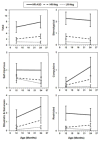Longitudinal patterns of repetitive behavior in toddlers with autism
- PMID: 24552513
- PMCID: PMC4107191
- DOI: 10.1111/jcpp.12207
Longitudinal patterns of repetitive behavior in toddlers with autism
Abstract
Background: Recent evidence suggests that restricted and repetitive behaviors may differentiate children who develop autism spectrum disorder (ASD) by late infancy. How these core symptoms manifest early in life, particularly among infants at high risk for the disorder, is not well characterized.
Methods: Prospective, longitudinal parent-report data (Repetitive Behavior Scales-Revised) were collected for 190 high-risk toddlers and 60 low-risk controls from 12 to 24 months of age. Forty-one high-risk children were classified with ASD at age 2. Profiles of repetitive behavior were compared between groups using generalized estimating equations.
Results: Longitudinal profiles for children diagnosed with ASD differed significantly from high- and low-risk children without the disorder on all measures of repetitive behavior. High-risk toddlers without ASD were intermediate to low risk and ASD positive counterparts. Toddlers with ASD showed significantly higher rates of repetitive behavior across subtypes at the 12-month time point. Repetitive behaviors were significantly correlated with adaptive behavior and socialization scores among children with ASD at 24 months of age, but were largely unrelated to measures of general cognitive ability.
Conclusions: These findings suggest that as early as 12 months of age, a broad range of repetitive behaviors are highly elevated in children who go on to develop ASD. While some degree of repetitive behavior is elemental to typical early development, the extent of these behaviors among children who develop ASD appears highly atypical.
Keywords: Autism; high-risk siblings; repetitive behavior.
© 2014 The Authors. Journal of Child Psychology and Psychiatry. © 2014 Association for Child and Adolescent Mental Health.
Conflict of interest statement
Conflicts of interest statement: No conflicts declared.
Figures


Comment in
-
'What's up, (R)DoC?'--can identifying core dimensions of early functioning help us understand, and then reduce, developmental risk for mental disorders?J Child Psychol Psychiatry. 2014 Aug;55(8):849-51. doi: 10.1111/jcpp.12293. J Child Psychol Psychiatry. 2014. PMID: 25039570
References
-
- American Psychiatric Association. Diagnostic and Statistical Manual of Mental Disorders. 5. Washington, DC: Author; 2013.
-
- Arnott B, McConachie H, Meins E, Fernyhough C, Le Couteur A, Turner M, Leekam S. The frequency of restricted and repetitive behaviors in a community sample of 15-month-old infants. Journal of Developmental and Behavioral Pediatrics. 2010;31(3):223–9. - PubMed
-
- Barber AB, Wetherby AM, Chambers NW. Brief report: repetitive behaviors in young children with autism spectrum disorder and developmentally similar peers: a follow up to Watt et al. (2008) Journal of Autism and Developmental Disorders. 2012;42(9):2006–12. - PubMed
-
- Bishop SL, Richler J, Lord C. Association between restricted and repetitive behaviors and nonverbal IQ in children with autism spectrum disorders. Child Neuropsychology. 2006;12(4–5):247–67. - PubMed
-
- Bodfish JW, Symons FJ, Parker DE, Lewis MH. Varieties of repetitive behavior in autism: comparisons to mental retardation. Journal of Autism and Developmental Disorders. 2000;30(3):237–43. - PubMed
Publication types
MeSH terms
Grants and funding
LinkOut - more resources
Full Text Sources
Other Literature Sources

